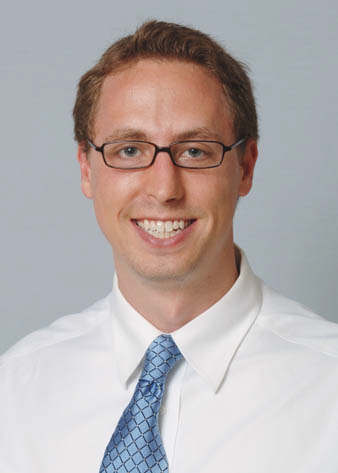 by Jim Harms, MD
by Jim Harms, MDI can still recall listening with awe to my sister, a medical student at the time, describe how she had learned to use physical exam techniques to diagnose disease. There’s something magical about the concept of being able to sit with a patient, and discover what they ail from using only your hands, senses, and intellect.When I became a medical student, crammed in study carrels for long hours, I was able to indulge my fascination as I read about eliciting egophony, or identifying a pericardial friction rub. Taking breaks between reading, I would excitedly discuss how these signs could be used to make a diagnosis, my carrel mates’ eyes slowly glazing over, and when I finished they would snap to and say, “Jim, you’re going to go into internal medicine.”
After testing the waters in my clinical rotations, it turns out they were right and I had the good fortune of coming to UAB as a resident in internal medicine. Somewhere between completing medical school and those first few months of internship I was lulled into the routine of the intern. My head was swimming with social issues, documentation, and discharge summaries instead of cardiac murmurs and breath sounds. When I heard the beep of my senior resident’s pager, and saw them take an admission, it became happenstance to hear, “60 year old male with pneumonia… already got vancomycin and zosyn, let’s look them up.’ Hearing these details I would quickly plunge into the EMR, assimilate background data, jot down CT scan findings, and begin to prepare the questions and salient exam maneuvers I’d need to perform to cement our suspected diagnosis. This dance became ritual, until I did my first month at the now defunct Cooper Green Hospital.
My senior resident for this month was Rolando Sanchez and he took a different approach to the day. He spent very little time documenting, and an abundance of time with us (his interns), and the patients. On our first call, I heard his pager buzz and waited while he returned the call from the ER. ‘What have we got?’ I queried. ‘That’s what you’re going to find out, Jim.’ Not expecting the night to go in this direction, my pulse quickened as I anxiously started wondering whom I was about to see and what they had presented with. In the ER I found a dyspneic middle-aged man, who I discovered had developed sudden onset pleuritic chest pain and shortness of breath. On my exam I found him to be hypoxic requiring oxygen by nasal cannula, tachycardic, and with clear lung sounds. My excitement began to grow as we looked over the EKG demonstrating signs of right ventricular strain, and we observed his clear chest film. ‘Rolando, I think this man has had a pulmonary embolism!’ Asking me for my next steps, I requested a CT Angiogram, which Rolando promptly presented, and confirmed my diagnosis! He had of course known the diagnosis from the start, but had allowed me to come to the conclusion on my own.
I began to develop new confidence and excitement in my ability to help patients. I readily expected to make the right diagnosis in every case we saw, because we would leave no stones unturned in our evaluation, which made our admissions an invigorating and satisfying experience. Aside of spending time with patients to obtain detailed histories and physical exams, what I noticed most about Rolando was his compassion. I watched him take additional time after rounds to return and speak with patients and their families. I saw him come in after hours to ensure that a decompensating patient was transferred to the ICU in a safe and timely manner. I found myself emulating these behaviors, and soon found that this part of my job was the most important thing I did as a physician. When I went home at night I didn’t stay awake thinking about Winter’s formula. Instead my mind would wander to the stories of the people I was taking care of.
As my residency, fellowship, and now career has progressed, the experience from that month has left an indelible mark on my mental image of what constitutes a physician. Though medicine as a field faces more challenges than ever to maintain the physician-patient relationship at the bedside, it is that interaction that sets us apart.
In the fall I was able to attend the Stanford 25 Skills Symposium with Dr. Stephen Russell. We were afforded the opportunity to learn about performing and teaching the physical exam from master clinicians from all over the world. It was an amazing experience I’ll never forget, and since the symposium Stephen and I have tried to bring some of what we learned back to UAB. We continue to collaborate and engage with other like-minded physicians we met there in hopes of growing bedside medicine here at UAB.
While it was mesmerizing to learn about the new forms of technology that can be used for medical education (it’s amazing what you can connect an iPhone to these days) and about Stanford’s teaching methodology, what impacted me most from the conference was the importance of the patient-physician interaction at the bedside. Dr. Abraham Verghese was a key speaker and demonstrator at the symposium, and while he had amazing technique and experience in the physical exam, it was observing his sage bedside manner that I found most inspirational. Equal parts caring and professional, it conveyed an unspoken message that the patient was his primary concern, and that he was deeply invested in helping them. It reminded me of why I entered medicine, and what I learned those years ago during my internship.
The bond between patient and physician doesn’t rely solely on our skills, but also on the belief that we will do everything in our power to help them. We have the knowledge and ability, and most importantly because we care.